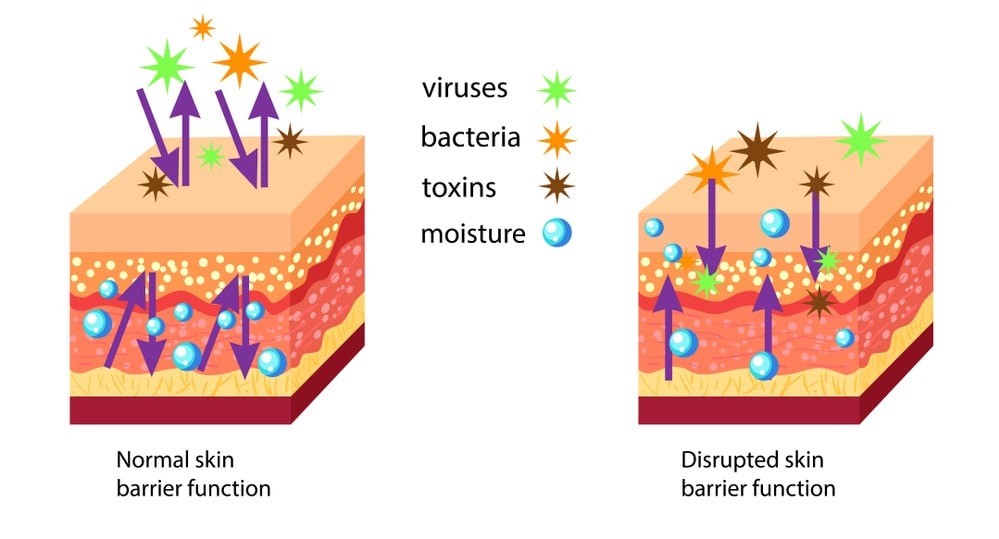It is the main protective organ of the body. Mostly deeper organs are protected. It prevents the invasion of pathogenic organisms and the entrance of harmful chemicals. The skin forms a waterproof layer, so dehydration is prevented. The skin contains nerve endings, so it can feel thus preventing the body from harm by its stimulus reaction.
Table of Contents
Temperature Regulation in the Body
The normal temperature of the body is about 36.5°C. In a healthy person, there is a slight temperature variation say about 0.5-0.75°C. During certain changes in physiological condition, such as exercise, just before ovulation, and in the evening, there is a slight rise in temperature besides the change in the metabolic rate; either temperature decreases or increases. During the metabolism of fats, carbohydrates, or protein food, some energy is produced in the form of heat, and also due to the contraction of voluntary muscles, maximum heat is produced. In the liver, various chemical activities take place and a large amount of heat is produced. Even during digestion, there is the contraction of smooth muscles, which also produces heat. Heat loss from the body occurs in various ways and maximum heat is lost through the skin. Some amount is lost during excretion, such as urine excretion, faces, or even exhaled air. But the heat lost through the skin can be controlled to maintain a constant body temperature. In the hypothalamus, there is a heat-regulating center, which controls the temperature of the circulating blood. The medulla oblongata contains a vasomotor center that controls the diameter of blood vessels. Due to dilation of the blood vessels, there is an increase in loss of heat by radiation, conduction and convection and by narrowing the blood vessel, heat loss from the body is reduced. heat loss from the body is reduced.
The skin contributes to thermoregulation, the homeostatic regulation of body temperature occurs in two ways:
- By liberating sweat at its surface by adjusting the flow of blood in the dermis.
- In response to high environmental temperature or heat produced by exercise, sweat production increases; the evaporation of sweat from the skin surface helps to lower body temperature.
In addition, blood vessels in the dermis of the skin dilate; consequently, more blood flows through the dermis, which increases the amount of heat loss from the body. In response to low environmental temperature, the production of sweat is decreased, which helps to conserve heat. Also, the blood vessels in the dermis of the skin constrict, which decreases blood flow through the skin and reduces heat loss from the body. If there is a slight temperature rise, sweat glands become active to secrete sweat. This sweat is carried towards the surface of the skin by the sweat duct. Sweat is evaporated, so it helps in cooling body temperature.

Blood reservoir:
The dermis houses an extensive network of blood vessels that carry 8-10% of the total blood flow in resting adults. For this reason, the skin acts as a blood reservoir.
Protection:
The skin protects the body in various ways.
- Keratin protects underlying tissues from microbes, abrasion, heat, and chemicals, and tightly interlocked keratinocytes resist invasion by microbes.
- The oily sebum from the sebaceous glands keeps skin and hairs from drying out and contains bactericidal chemicals that kill surface bacteria.
- The acidic pH of perspiration retards the growth of some microbes.
- The pigment melanin helps shield against the damaging effects of UV light.
- The lipids released by lamellar granules retard evaporation of water from the skin surface, thus guarding against dehydration; they also retard entry of water across the skin surface during showers and swims.
Cutaneous sensation:
Cutaneous sensations are sensations that arise in the skin, including tactile sensations-touch, pressure, vibration, and tickling as well as thermal sensations such as warmth and coolness. Another cutaneous sensation, pain, usually is an indication of impending or actual tissue damage. There is a wide variety of nerve endings and receptors distributed throughout the skin, including the tactile discs of the epidermis, the corpuscles of touch in the dermis, and the hair root plexus around each hair follicle.
Excretion and Absorption:
The skin normally has a small role in excretion, the elimination of substances from the body and absorption, the passage of materials from the external environment into body cells.
- Despite the almost waterproof nature of the stratum corneum, about 400 ml of water evaporates through it daily. A sedentary person loses an additional 200 ml of per day as sweat; a physically active person loses much more.
- Besides removing water and heat from the body, sweat also is a vehicle for the excretion of small amounts of salts, carbon dioxide, two organic molecules that result from the breakdown of protein i.e. urea and ammonia.
- The absorption of water-soluble substances through the skin is negligible, but certain lipid-soluble materials do penetrate the skin. These include fat-soluble vitamins (A, D, E, and K), certain drugs, and gases oxygen, and carbon dioxide.
- Toxic materials that can be absorbed through the skin include organic solvents such as acetone (in some nail polish removers) and carbon tetrachloride (dry cleaning fluid); salts of heavy metals such as lead, mercury, and arsenic; and substances in poison ivy and poison oak.
- Since topically applied steroids such as cortisone, are lipid-soluble, they move easily into the papillary region of the dermis. Here, they exert their anti-inflammatory properties by inhibiting histamine production by mast cells.
Synthesis of Vitamin D:
Synthesis of vitamin D requires activation of a precursor molecule in the skin by UV rays in sunlight. Enzymes in the liver and kidneys then modify the activated molecule, finally producing calcitriol, the most active form of vitamin D. Calcitriol is a hormone that aids in the absorption of calcium in foods from the gastrointestinal tract into the blood.
Make sure you also check our other amazing Article on: Nervous Tissue
